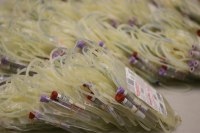Every fall and spring, Renaissance members host a blood drive through the Red Cross here to help provide blood to those in need, whether it be for testing or for transfusions. Little do many know, that donating blood or volunteering at these drives can earn students a graduation cord.
This is the first year that this opportunity has been offered on a nationwide level. Students can be qualified to receive a cord by volunteering with the Red Cross for eight hours or more or by donating blood three or more times, one of which must be done over the summer.
The program was first established to encourage students to get a head start on donating, according to Nathaniel Saunders, a donor recruitment representative for the Red Cross. There is a constant need for blood, and one way to help close the gap is for students to get involved in the donation process, either by actually donating or volunteering.
Offering a cord, scholarship, and letter of recommendation are incentives offered to students who participate. This strategy was developed by the Red Cross to try and encourage more students become involved with the Red Cross as well as to reward those who were already involved.
Senior Jason Green has donated blood six times so far. He chooses to donate because his blood is universally accepted by blood recipients and wants to do all he can to help those in need of blood transfusions. One blood donation can save up to three lives.
“[Donating] is a great way to help people in need. Blood transfusions are common, and we don’t have enough blood to keep up with the demand. Donating helps to ease that demand just a bit, which is a nice feeling,” Green said.
If one meets the requirements of receiving a cord, they can go to the Red Cross’s website and create an account, which is used to track donations and volunteering.
Saunders encourages students to become involved with the Red Cross.
“It is [the Red Cross’] goal that this program continues to grow year over year as more students hear about it and want to participate,” Saunders said in an email correspondence.
Students who volunteer or give blood do not have to do so at a school-hosted event, though schools are encouraged to host three blood drives per year to help students have an easier time becoming eligible for the program.
Unfortunately, many students are not able to give blood because of restrictions in the blood donation process. Fortunately, because of the option to volunteer to be able to receive a cord, these students have an equal opportunity to get a cord.
Senior Emily Smart has been in charge of hosting the Red Cross with Renaissance here for the past three blood drives. She suggests getting involved if there is any interest in helping.
“It is fun and the feeling you get at the end of the day is priceless. I know a lot of kids that get deferred or already know they can’t donate feel like they have no part in the blood drives. They can help though,” Smart said. “I always recommend finding someone if you’re interested in volunteering your time. [It is] just as important as donating.”
Additionally, if students donate blood three times and volunteer for eight hours they can qualify to receive a scholarship in addition to getting a cord. If they recommend five other students to donate they can also receive a letter of recommendation from their local Red Cross executive.
Unfortunately, current seniors who have not yet signed up to receive a cord have missed the deadline. However, current underclassmen are encouraged to start early and prepare for getting their cords before it is too late.
For students that qualify to receive a cord and and other of the benefits, it will be mailed to them in April of their senior year along with a thank-you note and keepsake pin.
For more information and to sign up to receive a cord, visit http://www.redcrossblood.org/leader/program-details











